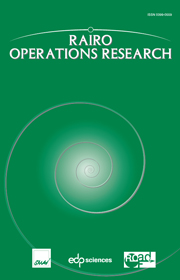No CrossRef data available.
Article contents
Finding the principal pointsof a random variable
Published online by Cambridge University Press: 15 August 2002
Abstract
The p-principal points of a random variable X with finitesecond momentare those ppoints in ${\mathbb R}$  minimizing the expected squared distance from X tothe closest point.Although the determination of principal points involves in general theresolution of a multiextremal optimization problem, existing procedures inthe literature provide just a local optimum. In this paper we show thatstandard Global Optimization techniques can be applied.
minimizing the expected squared distance from X tothe closest point.Although the determination of principal points involves in general theresolution of a multiextremal optimization problem, existing procedures inthe literature provide just a local optimum. In this paper we show thatstandard Global Optimization techniques can be applied.
Information
- Type
- Research Article
- Information
- Copyright
- © EDP Sciences, 2001
References
E. Carrizosa, E. Conde, A. Casta no, I. Espinosa, I. González and D. Romero-Morales, Puntos principales: Un problema de Optimización Global en Estadística, Presented at XXII Congreso Nacional de Estadística e Investigación Operativa. Sevilla (1995).
D.R. Cox, A use of complex probabilities in the theory of stochastic processes, in Proc. of the Cambridge Philosophical Society, Vol. 51 (1955) 313-319.
Flury, B. and Tarpey, T., Representing a Large Collection of Curves: A Case for Principal Points.
Amer. Statist.
47 (1993) 304-306.
R. Fourer, D.M. Gay and B.W. Kernigham, AMPL, A modeling language for Mathematical Programming. The Scientific Press, San Francisco (1993).
Gelenbe, E. and Muntz, R.R., Probabilistic Models of Computer Systems-Part I.
Acta Inform.
7 (1976) 35-60.
CrossRef
Horst, R., Algorithm, An for Nonconvex Programming Problems.
Math. Programming
10 (1976) 312-321.
CrossRef
R. Horst and H. Tuy, Global Optimization. Deterministic Approaches. Springer-Verlag, Berlin (1993).
Lloyd, S.P., Least Squares Quantization in PCM.
IEEE Trans. Inform. Theory
28 (1982) 129-137.
CrossRef
Li, L. and Flury, B., Uniqueness of principal points for univariate distributions.
Statist. Probab. Lett.
25 (1995) 323-327.
CrossRef
Pötzelberger, K. and Felsenstein, K., An asymptotic result on principal points for univariate distribution.
Optimization
28 (1994) 397-406.
CrossRef
Rowe, S., Algorithm, An for Computing Principal Points with Respect to a Loss Function in the Unidimensional Case.
Statist. Comput.
6 (1997) 187-190.
CrossRef
Tarpey, T., Two principal points of symmetric, strongly unimodal distributions.
Statist. Probab. Lett.
20 (1994) 253-257.
CrossRef
Tarpey, T., Principal points and self-consistent points of symmetric multivariate distributions.
J. Multivariate Anal.
53 (1995) 39-51.
CrossRef
Tarpey, T., Li, L. and Flury, B., Principal points and self-consistent points of elliptical distributions.
Ann. Statist.
23 (1995) 103-112.
CrossRef
Zoppè, A., Principal points of univariate continuous distributions.
Statist. Comput.
5 (1995) 127-132.
CrossRef
Zoppè, A., Uniqueness, On and Symmetry of self-consistent points of univariate continuous distribution.
J. Classification
14 (1997) 147-158.
CrossRef

